Longstanding Alaska Dilemma
Notice to International Readers: This site can be read in six languages. Just peck the popup at the bottom of the page to change from English. Ang site na ito ay mababasa sa anim na wika. I-peck lang ang popup sa ibaba ng page para magpalit mula sa
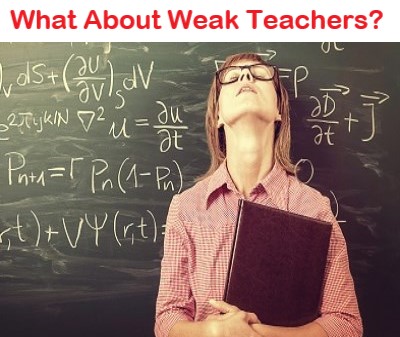
Updated version originally published: February 28, 2016 NorthernRight.com
Editor’s Note: As the Alaska Legislature is once again barraged by special interests insisting the State of Alaska must provide increased funding for Public Education factories despite our bottom-of-the nation academic outcomes in 50+ Alaska School Districts, perhaps it’s time to review how Alaska Public Education has declined over the last decade. I wrote and published this story in 2016 as a certified AK teacher since 2003.
Over the holidays Cathy and I spent time with family Outside in Oregon, some of whom I have not seen in quite a long time. One lovely woman whom I last saw more than two decades ago approached me familiarly and enthused that she heard I was now a teacher! She works as an instructional aide in a high school, and her fiancé is a teacher who works mostly with STEM curriculum and is also the district’s NEA union president.
She was happy that we have so much in common.
I explained that I am certified but as a classroom teacher I learned after a few parent-teacher conferences that children who have parents who do not take education seriously tend to have kids who do not take education seriously. Thus, for the last six years I have worked in Adult Basic Education helping people who were unsuccessful or quit or were kicked out of the public education system. Also, I informed her partner; I worked nine years for NEA-Alaska and was very familiar with that part of the education business, too. I saw no point in asking these folks why they thought 20-25 percent of their students must ultimately get a GED.com.

We had little direct conversation after that introduction but later I heard her talking on several occasions about what kinds of things she did in her job. At one point I listened as she articulated her perspective on MATH. As a “Study Hall Monitor,” she explained, she NEVER tried to help students with math. She reportedly tells all students she cannot assist with math–they will have to find someone else to coach them on their math homework.
I was struck by the message this sends to students under her charge. She, a middle-aged woman working in a high school as a teacher aide, neither understood nor cared about math. For her, math had no importance in her life and for anyone who was so cursed as to have math homework, another school employee (or student!) who did care about math would have to be found.
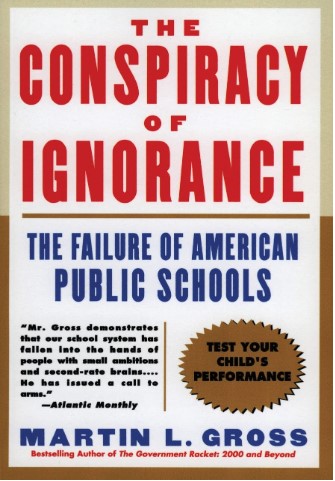
The Conspiracy of Ignorance
In 1992 Martin L. Gross wrote a book that struck a nerve in the United States as Billionaire Ross Perot was running a third-party campaign for president, in an election that would elect National Education Association (NEA)-endorsed President, Bill Clinton. The book, The Government Racket reportedly outlined -government waste “from A to Z.” Goodreads.com enthused: “Learn why our government costs too much and delivers too little to too few Americans!”

[1] Good Reads review of The Government Racket, Martin L. Gross.
In 1999 Mr. Gross wrote another book, The Conspiracy of Ignorance, documenting failure of American public schools. He wrote: For the past half century, the argument in public education has been between enthusiastic proponents of the “progressive” theories of John Dewey and the “traditionalists,” who look back fondly on a vanished rigor. Today the difference still exists, but there is increasing agreement by many on both sides that we are faced with an educational crisis that cuts across all philosophical concerns. Simply stated, American public schools, from kindergarten through the senior year of high school, are miserably failing their students and the society.
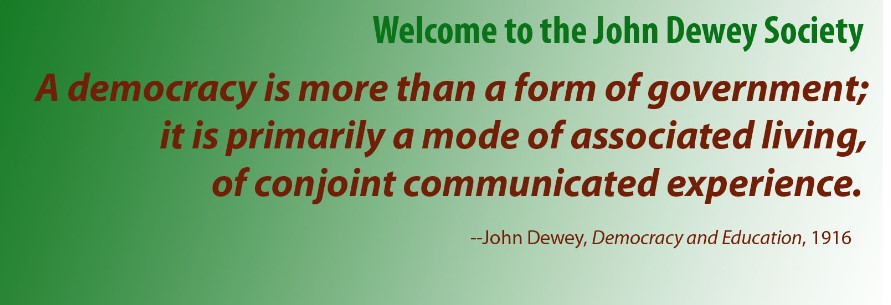
[2] National Endowment for the Humanities: Dewey was a radical reformer, a socialist, a secular humanist, a meliorist, even a utopian.
A need for educational reform had earlier been declared by a presidential commission which in April of 1983 published its report entitled A Nation at Risk. President Ronald Reagan’s Secretary of Education, T. H. Bell had created the National Commission on Excellence in Education on August 26, 1981, directing it to examine the quality of education in the United States and to make a report to the Nation. The final report begins with an ominous statement:
Our Nation is at risk. Our once unchallenged preeminence in commerce, industry, science, and technological innovation is being overtaken by competitors throughout the world. This report is concerned with only one of the many causes and dimensions of the problem, but it is the one that undergirds American prosperity, security, and civility. We report to the American people that while we can take justifiable pride in what our schools and colleges have historically accomplished and contributed to the United States and the well-being of its people, the educational foundations of our society are presently being eroded by a rising tide of mediocrity that threatens our very future as a Nation and a people. What was unimaginable a generation ago has begun to occur–others are matching and surpassing our educational attainments.
If an unfriendly foreign power had attempted to impose on America the mediocre educational performance that exists today, we might well have viewed it as an act of war. As it stands, we have allowed this to happen to ourselves. We have even squandered the gains in student achievement made in the wake of the Sputnik challenge. Moreover, we have dismantled essential support systems which helped make those gains possible. We have, in effect, been committing an act of unthinking, unilateral educational disarmament.
[3] Nation at Risk Declaration
https://www2.ed.gov/rschstat/research/pubs/risk25.html
As an employee of the Association of Alaska School Boards (AASB) in Juneau at that time, I personally recall the temporary remorse expressed by so many professional “educators” at the findings of this report. As the AASB Database Technician, I daily called superintendents or business managers in our more than 50 Alaska school districts collecting financial information for publication about Alaska’s public education money pit. This information was used in negotiations against the voracious appetites of the public sector unions who negotiated against hapless school boards in so many places. Back then, under Bob Greene as AASB Executive Director and Carole Burger as contract negotiator, an effort was actually being made to manage the exploding costs of public education in Alaska, with AASB taking it to the union at the negotiations table using financial and employee resource data, even though Alaska oil flow was at its peak.
Advertising is Available on this Site: Donn@DonnListon.net
In his book published a decade later, author Gross investigated the national education dilemma and his indictment of the Education Establishment was stark:
The costs of public education are high and rising, with little to show for it. Washington, for all its cackling about its reform program of Goals 2000, picks up only 6 percent of the $350 billion annual charge. The rest is paid by hard-pressed states, and by communities, which support the schools through property taxes, the fastest rising levy in the nation. From 1970 to 1999, the cost of living rose some fourfold, but the cost of education went up eightfold, with the same number of students as three decades ago.
[4] Martin L. Gross, “Conspiracy of Ignorance,” 1999, HarperCollins, publisher. P5
The culprits in this drama are members of the Public Education Establishment. Gross charges the five million “professionals” from classroom teachers to state education commissioners as being a near-monolithic force that controls public education in its entirety.

That establishment has shown itself to be an advocate of low standards, laxity, false educational theory and poor selection and training of teachers. It suffers from an inability to pass on the accumulated knowledge of civilization from one generation to the next. As time passes, that mental bank decreases, setting up the specter of grave prospects for the future.
National Education Goals had been announced by the President and adopted by the Governors in February of 1990. One of these Goals stated that students will demonstrate competence in challenging subject matter and exercise the rights and responsibilities of citizenship; another Goal states that American students will be first in the world in math and science achievement. Over succeeding years additional spadework was done to create a national plan for improvement of public education.

National educational Goals were set by the U.S. Congress at that time to institute “standards-based education reform.” It began in 1989 when President George H.W. Bush and 50 governors convened a historic Education Summit at Charlottesville, Virginia, and agreed to set education goals for the nation. The SBE reform movement calls for clear, measurable standards for all school students by measuring each student against an established concrete standard. Many of these goals were based on the principles of Outcome-Based Education (OBE); an educational theory that bases each part of an educational system around goals (outcomes). Under Goals 2000, by the end of the educational experience each student should have achieved the SBA goal, but not all of the goals were attained by the year 2000 as was intended. This was an attempt to establish a framework in which to identify world-class academic standards, to measure student progress, and to provide student support to meet the standards.
Simultaneous to this national effort another effort was occurring. In his book author Gross asserted that parents are often fooled by a continuous onslaught of Establishment Propaganda while research showed that some three-fourths of students complained that they were being short-changed in our public schools, not given demanding enough work. Thus, Mr. Gross described the Conspiracy of Ignorance:
In reality, it is a self-protective, virtually impenetrable closed circle. It selects our future teachers, trains them in its own academies, issues them its own undergraduate and graduate degrees, certifies them at the state licensing level, hires them for our schools, evaluates and promotes them.
It starts at the classroom level, goes up through the teacher union-guilds, to the principals, the school administrators, to the professors in the schools and departments of education, then up to the superintendents of schools in cities and suburbs. Finally, it reaches the state departments of education, where the Commissioner is usually a leading Establishment figure.

In other words, the purveyors of public education are not in touch with the national will to make public education accountable. The ambitious objectives of Goals 2000 never had a chance against the ingrown union-controlled education establishment.
Thus, the chance to throw more federal money at education was evident.
“The Goals 2000: Educate America Act (P.L. 103-227)” was signed into law on March 31, 1994, by President Bill Clinton. The Act provides resources to states and communities to ensure that all students reach their full potential. The law codified eight National Education Goals, added state legislators to the Panel membership, and charged the Goals Panel with new responsibilities. It also established a National Education Standards and Improvement Council (NESIC) to review and certify voluntary state and national education standards in conjunction with the Panel.
Goals 2000 sought the following benchmarks:
- All children in America will start school ready to learn.
- The high school graduation rate will increase to at least 90 percent.
- All students will leave grades 4, 8, and 12 having demonstrated competency over challenging subject matter including English, mathematics, science, foreign languages, civics and government, economics, the arts, history, and geography, and every school in America will ensure that all students learn to use their minds well, so they may be prepared for responsible citizenship, further learning, and productive employment in our nation’s modern economy.
- United States students will be first in the world in mathematics and science achievement.
- Every adult American will be literate and will possess the knowledge and skills necessary to compete in a global economy and exercise the rights and responsibilities of citizenship.
- Every school in the United States will be free of drugs, violence, and the unauthorized presence of firearms and alcohol and will offer a disciplined environment conducive to learning.
- The nation’s teaching force will have access to programs for the continued improvement of their professional skills and the opportunity to acquire the knowledge and skills needed to instruct and prepare all American students for the next century.
- Every school will promote partnerships that will increase parental involvement and participation in promoting the social, emotional, and academic growth of children.
- [5] Ibid, P9
Impact on Alaska Public Education
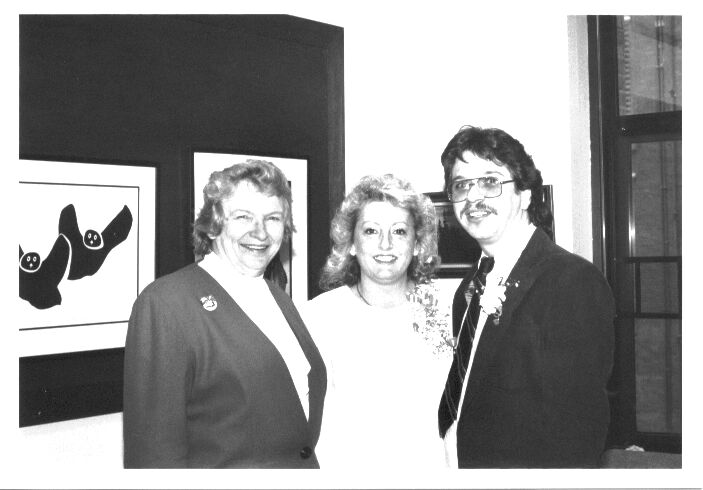
In the early 2000s this writer had decided to follow my earlier intention of becoming a teacher and returned to the University of Alaska Southeast where I had previously done all coursework toward gaining a Secondary Education Credential lacking only student teaching. Upon getting married in 1990 I had logically realized I should not give up a good job working for NEA-Alaska in Juneau to pursue non-paid student teaching for nine months or more. I had earned my Master’s Degree in Education in 1989 but now I convinced my wife that I really did want to be a teacher and finish the certification program. With her blessing I began taking coursework toward a k-8 certificate soon after President George Bush initiated the No Child Left Behind Act (NCLB). That Act required states to develop assessments in basic skills. To receive federal school funding, states had to give these assessments to all students at select grade levels. The Act did not assert a national achievement standard. Each individual state developed its own standards. NCLB expanded the federal role in public education through further emphasis on annual testing, annual academic progress, report cards, and teacher qualifications, as well as significant changes in funding.
For the First Time a National Attempt was made to make Public Education Accountable–And Teacher Unions Hated it. I heard the whining in many AK School Teacher Lounges first-hand.
What NCLB Required
Every activity proposed on every lesson plan I prepared in UA classes, and as a classroom teacher, had to be explicitly aligned with specific Alaska Educational Standards. Additionally, Alaska schools were required to provide High School Graduation Qualifying Exams (HSGQE) provided by the Alaska Department of Education twice per year, beginning in 10th grade. Students who did not pass the HSGQE–after having the opportunity to take it twice per year over three years–received a Certificate of Attendance instead of a diploma, but were afforded the opportunity to continue taking the test until they passed it. I personally helped many students work on the materials to pass that test.

Alaska Strives for Mediocrity
The 28th Alaska Legislature removed the requirement for Alaska students in public schools to pass the High School Graduation Qualifying Exam (HSGQE). That test was normed at 9th grade and students took it in April and in October each year if they didn’t pass it the first year, as most did. The last HSGQE was administered in Spring, 2014. When that test was dropped all students who had previously failed it were given their diplomas retroactively. After all, how could it be the students’ fault if they failed these basic tests after three years of high school instruction?
Accountability for academic outcomes of 50 Alaska School Districts doesn’t exist. Since at least 2014 Alaska students are routinely graduated with 10th-11th grade diplomas while the GED was that same year upgraded to be nationally normed at 12th grade. Homeschool parents can be sure their students have a 12th grade education if they can pass the GED,
HSGQE Standard Based Assessments were replaced by Alaska Measures of Progress (AMP) and College and Career-Ready Assessments (SAT and ACT). The Kansas vendor providing the AMP test has been blamed for Alaskan students doing poorly on the test, while many Alaska superintendents have complained that the custom test did not provide enough information to help teachers better instruct students. The Alaska Commissioner of Education has notified the State Board of his resignation as the board declares it is seeking a new direction for Alaska education policy.
Alaska’s Public Education is managed by an extensive bureaucracy residing in the same building as the Permanent Fund Corporation in Juneau.
It is obvious that Alaska needs to move in a new direction. According to the National Center for Educational Statistics, this is where Alaska students stand among the states in 2016 and 2022:
Fourth Grade Competency–Math: According to the National Assessment of Educational Progress (NAEP), Alaska’s 2015 scale score for 4th Grade math was 236, placing it above only four other U.S. states. Alaska has continuously trailed the average scale score of the U.S. since at least 2003, although it was ahead of the national score (224 to 222) in the 1996 study. About 22 percent of 4th grade students in Alaska public education are below basic math skill levels, 78 percent are at basic skill levels, 29 percent are proficient level and six percent are above proficient. (http://nces.ed.gov/nationsreportcard/states/chartsview.aspx?jur=AK&sbj=M…)
Update:
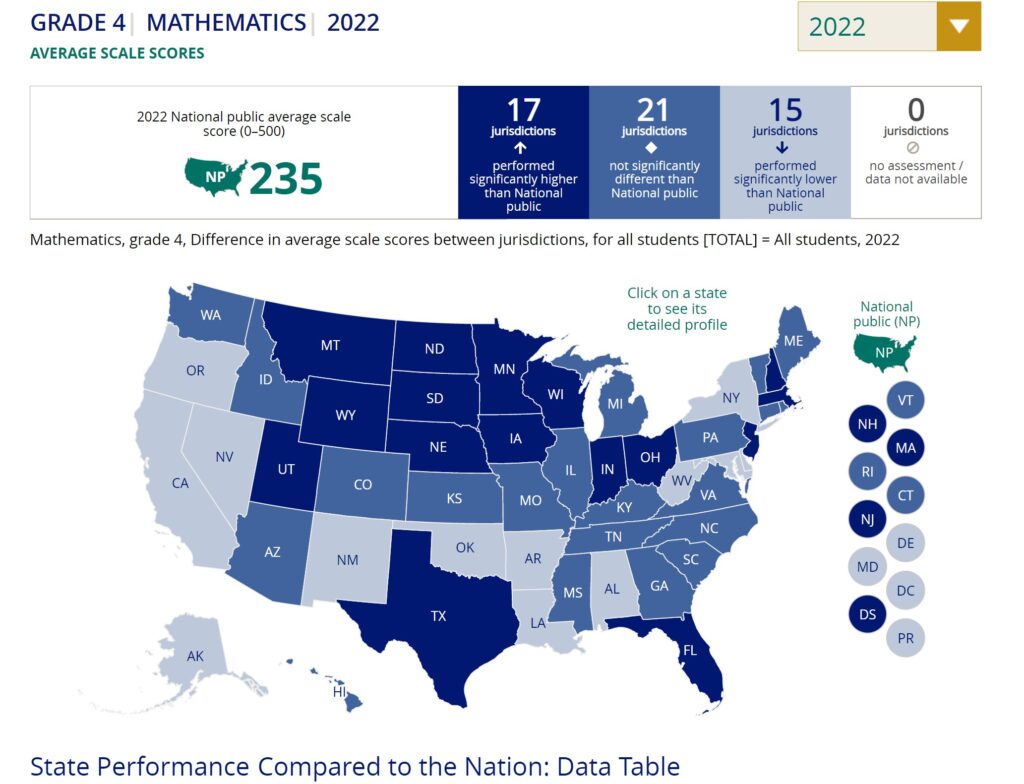
Fourth Grade Competency—Reading: Average NAEP 2015 Reading scale score for Alaska 4th grade students was 213, considerably behind the national average of 221. Only one state has a lower ranking in this area while 41 jurisdictions score higher. Some 39 percent of Alaska students are below basic skills in this category, while 61 percent are at or above basic skills, and 30 percent are competent. Six percent are advanced. http://nces.ed.gov/nationsreportcard/states/chartsview.aspx?jur=AK&sbj=R…
Update:
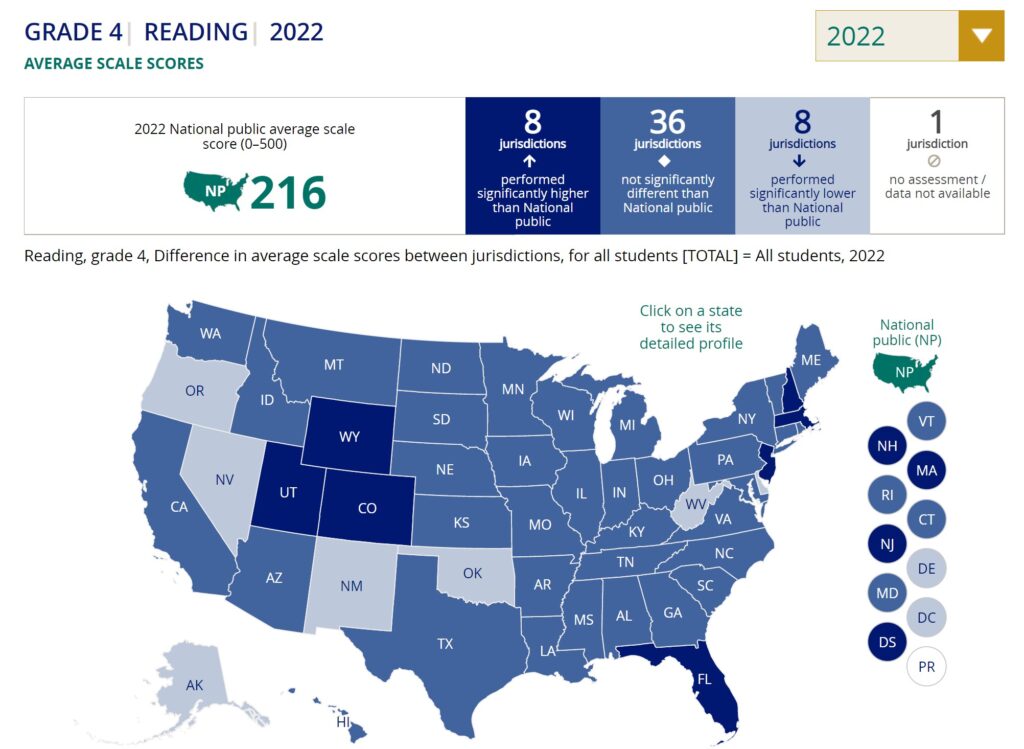
Eighth Grade Competency–Math: Average NAEP 2015 math scale score for Alaska 8th grade students was 280, which is only one point behind the national scale score average of 281. Among the states 23 did better than Alaska in this category while 12 did worse. Until 2009 Alaska was continuously ahead of the national average on this measure with the 1996 score considerably ahead of the national average (278 to 271). http://nces.ed.gov/nationsreportcard/states/chartsview.aspx?jur=AK&sbj=M…
Update:

Eighth Grade Competency—Reading: Average NAEWP 2015 reading scale scores for Alaska 8th grade students was 260, a score ahead of only four other states and behind 32 states. Among the students measured, 29 percent were below basic skills, 71 percent demonstrated basic skills and 31 percent were proficient. Only three percent tested as advanced. (http://nces.ed.gov/nationsreportcard/states/chartsview.aspx?jur=AK&sbj=R…
Update:

High school results after attending schools providing this level of achievement are predictable.
Parents who have students age 16 or older might consider having their children take practice tests for the GED (GED.com) to get an independent assessment. Students who do well on such practice tests may go ahead and schedule to take the GED test at an approved testing center. The GED is given in Math, Science, Language Arts and Social Studies. After taking any of them the tests a report tells where to study in the instruction manual published by Kaplan, if more study is needed.
In my experience, student’s first teachers, Mom and Dad, are REQUIRED to help them succeed in this institutional SCAM.
References:
[1] Good Reads review of The Government Racket, Martin L. Gross.
http://www.goodreads.com/author/show/29050.Martin_L_Gross
[2] National Endowment for the Humanities: Dewey was a radical reformer, a socialist, a secular humanist, a meliorist, even a utopian.
https://www.neh.gov/article/john-dewey-portrait-progressive-thinker#:~:text=Dewey%20was%20a%20radical%20reformer,a%20meliorist%2C%20even%20a%20utopian.
[3] Nation at Risk declaration
https://www2.ed.gov/rschstat/research/pubs/risk25.html
[4] Martin L. Gross, “Conspiracy of Ignorance,” 1999, HarperCollins, publisher. P5
[5]ibid P9
[6] History of National Education Goals
http://govinfo.library.unt.edu/negp/page1-7.htm

Don,
I read this and was past President of the Alaska Federation of Teachers/AFT AFL/CIO for a couple of terms as well as my local union which I organized in the Anchorage School District and represented for a number of years (ACE/AFT). I had a number of positions and did a lot of work when “vouchers” were being promoted. Schools in Alaska are a gross failure from when my dad was a state Senator. #49th in the nation. It is time for a change. Have the money follow the student and start transferring the power of allocation to the schools parents choose Public or Private. A class in Anchorage of 30 works out to around $500,000 a year. Negotiate a central contract, health plan and retirement and let teachers and others set up schools. Remove the public barriers that are the failure. ….Ask yourself and any good teacher what would you do to shape the lives of 30 kids with a half a million dollars a year?…..Nick Begich
In the current Educational Environment, the State of Alaska must conform to the Federal Agenda in order to get the hundreds of millions of Federal Dollars. And you had better believe that is their intent. In order to change the outcomes, you have to change the educational ethos from the beginning to its stated end. While most children are eager to begin and do well in the first grade, by the 6th they have had it with school. Education is all about killing the desire to learn in the students it purports to be teaching. And that is why our results are so pathetic. The factory model of education is not going to cut it in the modern world. The minds of individual learners must be engaged in what is relevant and important to them. How this is done is just as important as what is being taught. The entire model of the school system needs to be reworked to create suitable environments for learning. “The medium is the message”, I was once told. And the “medium” is the tank our children are swimming in, educationally speaking. Without changing the “medium”, you cannot appreciably achieve better outcomes. “Hey, Dizzy, I heard you failed the first grade.” “I didn’t do so well in the second either,” he said. (Dizzy Dean was a star pitcher for the St. Louis Cardinals in the 1930’s.) You want to improve the education system ? Then change the system, because children are no worse than they were.